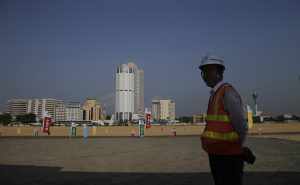Mohamed Zeeshan

In this Jan. 2, 2018, file photo, a Chinese construction worker stands on land that was reclaimed from the Indian Ocean for the Colombo Port City project, initiated as part of China’s ambitious One Belt One Road initiative, in Colombo, Sri Lanka.Credit: AP Photo/Eranga Jayawardena, File
When President Gotabaya Rajapaksa and his family stormed to power in Colombo in 2019, Beijing had much cause to celebrate. Only years earlier, the new president’s elder brother, Mahinda, had been instrumental in heralding a new era of Chinese influence in his country — hosting an array of dazzling infrastructure projects under Beijing’s flagship Belt and Road Initiative (BRI).
The projects had turned Sri Lanka into a strategic outpost in the Indian Ocean for Beijing. Geography had been especially significant: Sri Lanka gave China access to the waters beyond the Malacca Strait chokepoint between Malaysia and Singapore, through which much of China’s trade heading to Africa and West Asia passes.
But after Mahinda Rajapaksa lost power in 2015, a difficult period of coalition politics ensued, and Beijing lost the privileged access that it had previously enjoyed. When the Rajapaksa brothers finally returned to take the presidency in 2019 and win parliamentary elections with a thumping majority the following year, Beijing hoped that it could ramp up its presence in the Indian Ocean through further cooperation with them.
In the last few days, clashes have erupted on the streets of Colombo, costing lives and forcing Prime Minister Mahinda Rajapaksa to resign and be hastily airlifted out of his residence. The political crisis appears unlikely to be resolved soon, even as Sri Lanka struggles to gain access to funds in order to pay for its imports.
The ongoing meltdown in Colombo has brought about a spectacular change in fortunes for Chinese foreign policy, and it could also have serious implications for Beijing’s presence in the Indian Ocean and for the future potential of its global infrastructure investment plan.
Even before the Rajapaksas came to power in 2019, popular protests had hindered Chinese infrastructure projects in various parts of the country. But in the ongoing economic crisis, those projects have been bandied about by protestors as infamous examples of Sri Lanka’s crippling debt problem. A swanky port in Hambantota — the Rajapaksas’ hometown — cost $1.4 billion in Chinese loans, but it lost $300 million in six years. An airport was built nearby with a $200 million loan from China, but it has been used so sparingly that it was unable to cover even its own electricity bills at one point. A conference center in the same city cost over $15 million, but it has remained largely unused, according to reports.
China’s failed projects are already helping fuel criticism that its infrastructure investment is a “debt trap.” These stories will especially spark concern in many poor countries with income levels far below Sri Lanka’s. If Sri Lanka — a country that has led South Asia on multiple socioeconomic indicators for several years — couldn’t recover profits from such swanky infrastructure, Chinese debt is unlikely to reassure the likes of Nigeria, Kenya or Ethiopia.
But making matters worse has been China’s own response to the crisis. So far, Beijing has been conspicuous in its absence in terms of offering assistance to Colombo. Prior to its default on foreign loans, Sri Lanka had appealed to Beijing to have its loans rescheduled. But China was reluctant to roll over loans under BRI, fearing that it would set a bad precedent for its investment in other parts of the world. Ultimately, Sri Lanka went to the IMF for help.
To some extent, Beijing’s own hands have been tied. A fresh outbreak of COVID-19 in China’s major cities has poked holes in President Xi Jinping’s “zero-COVID” policy. Shanghai has been under strict lockdown rules for weeks, sparking widespread discontent and economic passivity. This April, industrial output across China had fallen by 2.9 percent compared to a year earlier. Retail sales had shrunk by over 11 percent year on year.
But through its absence, China has now yielded strategic space to India. So far, New Delhi has extended over $3 billion in financial assistance to Colombo and deferred repayment of loans worth at least $2 billion. India’s influence during the crisis has been so far-reaching, in fact, that one student protestor in Colombo told Quartz, “If [the Indians] ask the president for the clothes off his back, he has to give them up.”
With the spotlight firmly on Ukraine, Beijing might not currently give much thought to its vanishing foothold in Sri Lanka. But if the crisis persists in Colombo, it could have long-term repercussions for China’s strategic influence in the Indian Ocean and the future of its Belt and Road Initiative.
No comments:
Post a Comment